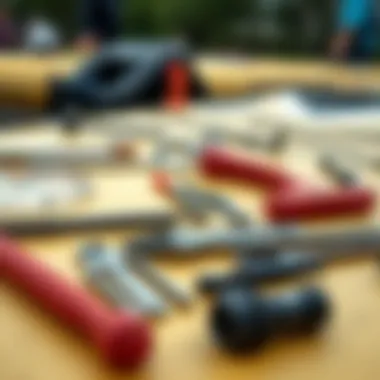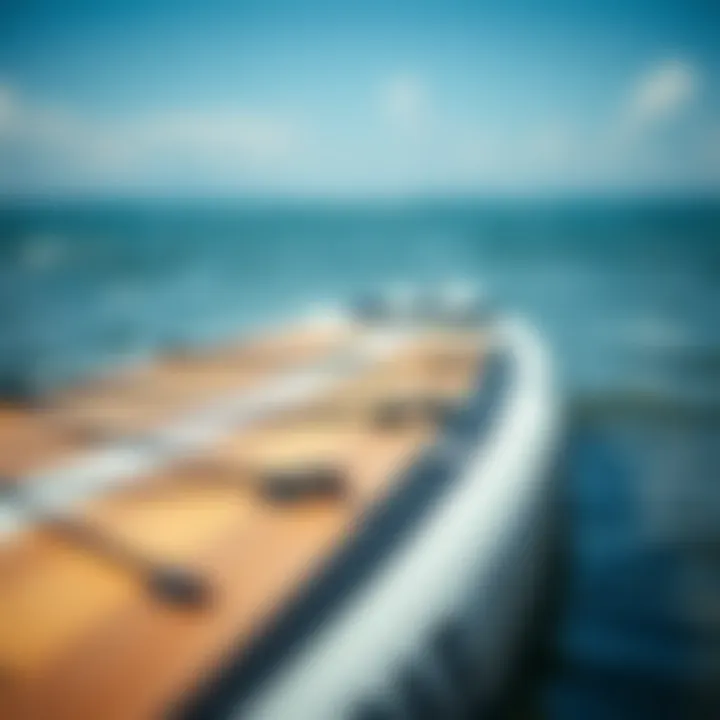Your Ultimate Guide to Inflatable Paddle Board Repairs


Intro
Inflatable paddle boards have surged in popularity among water sports lovers, providing flexibility and portability that traditional boards may lack. However, with regular use, wear and tear can take a toll. Understanding how to maintain and repair your gear is crucial for longevity and performance. This guide is all about shedding light on the nitty-gritty of inflatable paddle board repair, making it accessible for everyone from the weekend warrior to the seasoned pro.
Repairing inflatable paddle boards doesn’t have to be a daunting task. Instead, it can be a fun learning experience, especially when you know the right methods and tools. With a plethora of techniques available nowadays, it’s quite handy to know what works best in different situations. Whether it's a simple puncture or a more complex tear, proper repair knowledge can save you from unnecessary replacement costs, ensuring that your paddle board remains your ultimate companion on the water for years to come.
This comprehensive guide will journey through methods for maintaining your gear, the necessary tools for repairs, and also local resources that can offer professional help. We’ll highlight basic DIY techniques for those adventurous souls who wish to get their hands dirty, while also discussing when it might be wise to seek external assistance. By the end of this article, you will have a thorough understanding of how to keep your inflatable paddle board in top shape.
Understanding Inflatable Paddle Boards
Inflatable paddle boards have carved a niche for themselves in the world of water sports, gaining popularity due to their portability and versatility. Unlike traditional hardboards, they can be deflated and rolled up for easy transport, fitting neatly into a car trunk or even a backpack. This section is crucial as it lays the groundwork for understanding what makes these boards function effectively and highlights the significance of knowing their construction and potential issues that one might encounter.
Construction Materials and Design
The design of inflatable paddle boards typically involves several layered materials that provide both durability and flexibility. The outer surface is often made from high-quality PVC or military-grade fabric, which not only protects against punctures but also withstands the wear and tear of outdoor use.
An effective design incorporates a drop-stitch construction method, where thousands of threads connect the top and bottom layers of the board, allowing it to maintain a rigid shape when inflated. This ensures a stable paddling experience.
Some boards may include additional features like reinforced rails or UV-protective coatings that offer extra protection against sun exposure, which can degrade materials over time.
Advantages of Inflatable Paddle Boards:
- Portability: Easily transportable once deflated, making it simple to take them on trips.
- Durability: Designed to resist impacts from rocks or other hard surfaces.
- Versatility: Suitable for various activities, from yoga to touring and even surfing, depending on their shape and design.
Considerations:
- It's worth noting that while they are tough, sharp objects can still puncture the material. Thus, being aware of the environment while paddling is important.
- In addition, users should consider the type of paddle board suitable for their specific activities. An all-around board may not deliver the same performance as one specifically designed for racing or surfing.
Common Issues Encountered
Despite their many advantages, inflatable paddle boards are not immune to problems. Understanding these common issues can help users maintain their boards better and be prepared to handle repairs when necessary.
- Punctures and Leaks: Accidental punctures can occur due to sharp objects or improper handling. These are among the most frequent issues users face.
- Air Loss: Sometimes boards may experience gradual air loss, often due to faulty valves or small leaks that are difficult to detect.
- Dirt and Stains: Regular use in water can result in water stains or dirt accumulation. If not cleaned promptly, these can become permanent.
- Deformation: Extended exposure to heat or being tied down too tightly can lead to deformation, affecting the board's shape and performance.
Recognizing these common problems is half the battle. The key is to adopt a proactive approach, regularly inspecting and maintaining the board to ensure a smooth experience out on the water. Regular checks can help catch minor issues before they escalate into major repairs, prolonging the life of an inflatable paddle board.
With a solid understanding of inflatable paddle boards, paddle board enthusiasts can navigate both their setup and maintenance with confidence.
The Importance of Timely Repairs
Timely repairs are crucial for maintaining the longevity and performance of inflatable paddle boards. Neglecting even minor damages can lead to larger issues down the line, making it imperative for paddle board enthusiasts to address any concerns promptly. Assessing and repairing damages early prevents further deterioration, ensures safety during usage, and protects your investment.
Impact on Performance and Safety
The performance of an inflatable paddle board hinges on its integrity. Even a small puncture or tear can drastically decrease its performance on the water. When the board leaks air, it may become unstable and challenging to maneuver, which can affect your balance and speed. More importantly, safety becomes a major concern. A compromised board can capsize easily, putting riders at risk of injury.
For athletes, coaches, and recreationists, the stakes are higher. Imagine paddling in open waters only to discover your board losing air. This scenario can be avoided with timely repairs. Maintaining optimal performance not only boosts your paddling experience but also minimizes risks, allowing you to enjoy the adventure without worrying about your equipment.
"An ounce of prevention is worth a pound of cure." Keeping your board in top condition ensures you can paddle without unexpected hiccups.
Preventative Maintenance Tips
Preventative maintenance is the key to reducing the need for repairs. Following a few simple practices will help keep your inflatable paddle board in good shape:
- Routine Inspection: Before and after each use, take a few minutes to inspect your board for any visible signs of wear, such as cracks, scratches, or air leaks. Check the valves to ensure they are functioning correctly.
- Proper Cleaning: After each outing, wash your board with fresh water to remove salt, dirt, and debris that could cause damage over time. Using non-abrasive cleaners is advisable to avoid scratching the surface.
- Storage Care: Store your paddle board in a cool, dry place out of direct sunlight to prevent material degradation. Using a board bag can provide extra protection during storage and transport.
- Regularly Apply UV Protectant: Some materials degrade with sun exposure. Using a UV protectant can prolong the life of your board’s exterior, keeping it looking fresh and functioning smoothly.
- Inflation Maintenance: Ensure your board is inflated to the manufacturer’s recommended pressure. Under-inflation can cause excessive flexing, while over-inflation can risk punctures.


By integrating these maintenance habits into your routine, you can mitigate future repairs, enhancing both your experience and safety on the water. Keeping a close eye on your inflatable paddle board ensures you maximize its performance and lifespan.
DIY Repair Techniques
Taking the matter of inflatable paddle board repair into your own hands is not just a smart way to save some dollars, it can also become a highly satisfying endeavor. By employing DIY repair techniques, you gain the ability to fix minor issues before they escalate into larger problems. Moreover, learning how to address common damages fosters an understanding of your equipment—ultimately enhancing your connection to the sport. Here’s how to get your hands dirty and keep your paddle board in tip-top shape.
Identifying the Damage
First off, understanding the nature of the damage is crucial. After a day out on the water, inspect your board thoroughly. Common signs of wear include:
- Surface Punctures: These may manifest as small holes or deeper scratches. They often come from sharp objects like rocks or bumping against rough surfaces.
- Seams Coming Apart: Stress or excessive folding can lead to seam separation. This issue often sneaks up on you and can lead to air leaks.
- Inflation Problems: If your board isn't holding air like it used to, it might be time to play detective. Listen for any hissing sounds or perform a dunk test—submerging parts of the board and looking for bubbling.
Knowing what you’re dealing with lays the groundwork for any repair efforts. Not all damage is made equal, so a good eye can help prioritize repairs, ensuring safety and performance.
Essential Tools for Repairs
When gearing up for repairs, having the right tools can mean the difference between a quick fix and a full-on disaster. Essential tools include:
- Repair Kit: Most inflatable paddle board brands include a repair kit. It generally comes with patches, adhesive, and sometimes, a small tool.
- Fine Sandpaper: This is great for prepping the surface around any punctures. A roughened area helps the adhesive bond better.
- Cleaning Solution: A mixture of mild soap and water can help clean off dirt and debris from the damaged area—make sure it’s totally dry before applying any adhesive.
- Utility Knife: This is helpful for cutting patches to the right size.
Gathering these items in advance means you won't be fumbling mid-repair, and that can save you both time and frustration.
Step-by-Step Repair Process
Once you identify the damage and have your tools at the ready, follow this straightforward process to patch things up:
- Clean the Area: Use your cleaning solution to scrub the damaged section—this ensures optimal adhesion.
- Prepare the Patch: Cut a patch larger than the damage area, ideally extending at least half an inch beyond the damaged spot in all directions.
- Sand the Surface: Lightly sand the area around the damage to create a more textured surface for better adhesion.
- Apply Adhesive: Generously apply the adhesive included in your repair kit to both the patch and the damaged area. Allow it to become slightly tacky as per the product instructions.
- Place the Patch: Firmly press the patch onto the damaged area. Make sure there are no air bubbles trapped beneath. Smooth it out with your fingers.
- Cure Time: Let the repair sit undisturbed for the recommended time in order for the adhesive to effectively bond. Avoid using the board during this period.
- Final Inspection: After it’s set, check the patch to ensure it’s secure. You can even test for leaks by inflating the board and submerging it again.
Being methodical with your repair process not only extends the life of your paddle board but can save you from more costly repairs down the line.
Remember, a well-maintained paddle board is not just a tool for fun; it’s your ticket to aquatic adventure. Keep your board in shape and it’ll reward you with endless summer days.
Professional Repair Services
When it comes to keeping an inflatable paddle board in top condition, the discussion of professional repair services can't be overlooked. While DIY methods can be highly effective for minor scratches or leaks, there are situations where the expertise of a professional becomes necessary. This section highlights the importance of knowing when to seek help from someone who truly understands the intricacies of paddle board materials and construction.
When to Seek Professional Help
Not all repairs are created equal. If you’re dealing with significant damage, such as a large puncture or a complete loss of air, that’s a red flag. Oftentimes, a simple patch job isn't sufficient for something that could compromise the board’s structural integrity. Here are a few scenarios when it’s wise to consider professional intervention:
- Major Punctures: If the tear is larger than a few inches, you might end up applying a patch that doesn’t adhere properly. This could lead to more problems down the line.
- Seam Issues: If you notice that the seams are coming loose, professional repair services have specialized techniques to reinforce them, ensuring they remain watertight.
- Complex Materials: Some boards are made of advanced composite materials requiring intricate knowledge to repair properly. If your board falls into this category, it’s better to leave it to the pros.
In these cases, seeking assistance ensures that your board is repaired effectively. It allows you to rest easy knowing it's been handled by someone knowledgeable.
Finding Services Near You
Once you've decided to entrust your paddle board to a professional, the next step is finding a reliable repair service nearby. The internet is an invaluable tool for this task. You can perform a simple search using phrases like "paddle board repair near me" or "inflatable SUP repair" to yield a variety of local options. Don't forget to take into account customer reviews on platforms like Yelp or Facebook; these can offer insight into the quality of customer service and repair work from other users’ experiences.
In addition, consider searching on forums like Reddit or local paddle board community pages to gather recommendations. You might also want to check out a few local shops specializing in water sports or outdoor activities, as they often have connections to dependable technicians. Multiple resources together are often essential to uncovering your best options.
Cost Considerations for Repairs
The cost of professional repairs can vary greatly depending on the extent of damage and the complexity of the repair. Generally speaking, minor fixes could range from $20 to $50, while larger, more complicated repairs could run upwards of several hundred dollars. Here are some elements to keep in mind regarding repair costs:
- Type of Repair: Just like any field, the specific service you need will directly influence the price. Routine maintenance tends to be less expensive compared to significant structural repairs.
- Local Market Rates: Prices can fluctuate depending on your location. Areas with a higher cost of living may see higher rates.
- Additional Services: Some technicians may offer add-ons, like a warranty on their work or specialized cleaning for your board, which may carry additional costs but contribute to long-term savings.
Always remember to get a quote beforehand to avoid any surprises later on. A well-made decision today might save you many dollars down the road.


Professional repair services are not just a convenience; they are an investment in the longevity and performance of your inflatable paddle board.
Choosing to engage professional services can make all the difference in getting your paddle board back into the water safely and efficiently.
Evaluating Repair Quality
Determining the quality of repair services is crucial for paddle board owners. An inflatable paddle board is not just a plaything; it’s an investment that deserves attention and care when it comes to repairs. When it malfunctions, the right repair could potentially extend its life and maximize its performance on the water. Conversely, poor repairs can lead to more significant issues down the line, compromising your safety and the paddle board’s longevity.
Knowing what to assess while evaluating a repair shop ensures that you receive nothing short of quality service. Factors to consider include the technician's expertise, reviews from previous customers, and the materials used for repairs. By focusing on these indicators, you're more likely to find a reliable service that can handle your inflatable board with the care it needs.
"Quality is never an accident. It is always the result of intelligent effort." – John Ruskin
Indicators of a Reliable Repair Shop
When you're searching for a reputable repair shop, several signs can help differentiate between a reliable service and one that might not meet your expectations:
- Certifications and Qualifications: Look for technicians who have specific certifications in inflatable equipment repair. This shows that they have undergone training and possess the necessary knowledge to handle repairs properly.
- Customer Reviews: Online reviews and testimonials are gold mines of information. Check platforms like Google Reviews or Yelp where customers voice their experiences. Positive feedback from fellow paddle board enthusiasts can indicate a trustworthy shop.
- Transparent Pricing: A reliable shop should provide clear estimates before starting any work. If a shop is vague about their charges, it could be a Red flag.
- Quality of Materials: Inquire about the types of materials and adhesives used for repairs. A good shop will use high-quality, durable materials suitable for paddle board repairs, rather than taking shortcuts with inferior products.
- Warranty on Repairs: Look for shops that offer warranties or guarantees on their work. This not only shows confidence in their repair quality but also provides you with security should issues arise post-repair.
Warranties and Guarantees
Understanding warranties and guarantees offered by repair services can provide an extra layer of assurance. A warranty typically covers specific repairs for a designated period after the initial service, meaning that if something goes wrong due to the initial repair, you can return for further assistance without incurring additional costs. This reflects the shop's commitment to delivering quality work.
When reading through the warranty terms, pay attention to:
- Duration: How long does the warranty last? Some might offer 30-day guarantees, while others may extend into months.
- What’s Covered: Ensure you understand what is covered under the warranty. For instance, does it include labor and materials?
- Exclusions: Be aware of any exclusions that could apply, like damage from misuse or neglect.
In the end, a thoughtful evaluation of repair quality, along with understanding warranties can save you a lot of trouble. No one enjoys discovering they’ve been let down by a faulty repair, especially when peace of mind on the water hinges on the integrity of your gear.
For further reading on quality repair services, you might explore resources like Wikipedia or visit relevant discussions on platforms such as Reddit.
The Role of Warranty in Paddle Board Repair
Understanding the warranty associated with your inflatable paddle board is essential. It's not just a piece of paper; it represents your safeguard against unforeseen damages and defects. A warranty can provide peace of mind, assuring you that if your board runs into trouble early on, the manufacturer stands behind its product. This section discusses the nuts and bolts of warranties, including the ins and outs of manufacturer warranties and the potential limitations you might face.
Understanding Manufacturer Warranties
When it comes to inflatable paddle boards, manufacturer warranties vary widely. Generally, these warranties cover defects in materials and craftsmanship for a defined period, often one to three years. To enhance your understanding, here's a quick rundown of what you should look for:
- Duration: This specifies how long you are protected. A longer warranty usually indicates the manufacturer’s confidence in their product.
- Coverage: Look closely at what’s included. Typically, manufacturing defects in seams, valves, and materials are covered.
- Conditions: Often, warranties come with conditions. For instance, certain types of negligence or damage due to misuse may void your warranty.
"It’s always better to read the fine print. Knowing what is covered— and what isn’t— can save you from being up the creek without a paddle later on."
To maximize your warranty’s benefits, it’s prudent to keep your purchase receipt and document any maintenance or repairs. Many manufacturers require proof of purchase for warranty claims, so a bit of organization can go a long way.
Limitations and Exclusions
While warranties provide critical protection, they also come with a fair share of limitations and exclusions. Manufacturers tend to incorporate these terms to ride the line between offering a reliable product and protecting themselves from frivolous claims. Here are some common limitations you might encounter:
- Accidental Damage: Most warranties don't cover damage caused by accidents, such as punctures from sharp objects or collisions with rocks.
- Wear and Tear: Normal wear and tear aren't typically covered. Over time, materials can degrade, and while it’s frustrating, that’s just part of the journey with inflatable boards.
- Improper Maintenance: If your board is not maintained according to the manufacturer’s guidelines, like failing to clean it regularly or exposing it to extreme temperatures, this can void your warranty.
In summary, it’s vital to understand the limits of your warranty. With this knowledge, you’ll know exactly what to expect and can take proactive measures to ensure your paddle board stays well within those boundaries. Always check the warranty policy when purchasing your board, as it can significantly impact your overall ownership experience.
Long-Term Care for Inflatable Paddle Boards
Taking care of your inflatable paddle board goes beyond having fun on the water. Just like a vehicle that needs regular tune-ups, your paddle board also requires a bit of attention to ensure longevity and optimal performance. Long-term care helps you to avoid costly repairs down the line and can really enhance your overall paddle boarding experience.
Proper Storage Techniques


Storing your inflatable paddle board the right way when it’s not in use is essential for maintaining its integrity. Here are some effective storage tips:
- Cool, Dry Location: Always store your paddle board in a cool and dry place. Avoid exposing it to direct sunlight for extended periods as UV rays can degrade the material over time. A garage or a shed usually works well.
- Avoid Sharp Objects: Ensure the storage area is clear of sharp tools or objects that might puncture the board. Even small cuts can turn into larger issues later on.
- Deflate When Storing: While it might be tempting to leave your board inflated for easy access, deflating it helps prevent unwanted stress on the seams and reduces the risk of popping.
- Use a Storage Bag: Consider using a storage bag that came with your board. If it didn’t come with one, look for a padded bag to offer an extra layer of protection.
These simple techniques can significantly contribute to prolonging the life of your inflatable paddle board.
Routine Inspection and Maintenance
Checking on your paddle board regularly can make a world of difference. Here’s how to keep it in check:
- Visual Inspections: Every couple of outings, inspect the board for any signs of damage, like punctures or abrasions. Look closely at the seams where potential leaks often occur.
- Pressure Check: If you’ve been using the board quite a bit, it's a good idea to check its air pressure. The board should feel firm to the touch. Under-inflation can result in poor performance and compromise the hull.
- Clean After Use: Rinse the board with fresh water after each trip. Salt or sand can weaken the materials over time. A gentle detergent can be used but avoid harsh chemicals that might harm the surface.
- Inspect Accessories: Don’t forget to check your paddle and pump. Make sure everything is functioning well to avoid issues when you are gearing up for your next adventure.
By taking the time for these routine maintenance checks, you can address minor issues before they balloon into major headaches.
Regular care today means fewer surprises tomorrow.
Resources for Paddle Board Enthusiasts
Finding the right resources can make all the difference when it comes to maintaining and repairing inflatable paddle boards. For enthusiasts, knowledge is power. By tapping into reliable sources, one can gain insights into best practices, discover tips for sourcing materials, and stay connected with a community of like-minded individuals. Not only does this bolster the confidence of paddlers, but it can also lead to more fulfilling experiences on the water.
Recognizing the importance of resources is crucial to ensure safety and enhance the paddle boarding experience. Knowledge about repair techniques, gear upkeep, or navigational options is essential for any serious paddler. Informative resources like forums and local clubs can bridge the gap between basic knowledge and advanced skills, aiding enthusiasts in every paddle stroke.
Online Communities and Forums
Online communities serve as invaluable resources for paddle board enthusiasts. They offer platforms for discussion, advice, and shared experiences. Through sites like Reddit, you can share your stories, ask questions, and learn from others who have walked the same path. This collaborative approach can lead to better repair outcomes and a deeper appreciation for the sport.
In particular, you might find specialized forums that focus on inflatable paddle boards, providing tailored advice ranging from DIY repair techniques to expert tips for even the novice paddler. These groups often feature:
- User-generated content: Members share their repair experiences, which can help others avoid common pitfalls.
- Product recommendations: Insights on tools and glue brands that work best can save time and money.
- Event announcements: Stay updated on gatherings or competitions within the community.
Additionally, sites like Facebook can also connect you to local groups. Engaging with these communities encourages a sense of camaraderie and provides a support system when tackling paddle board repair or upgrades.
Local Clubs and Events
Local clubs play an essential role in nurturing a passionate paddle boarding culture. These organizations can be found in many regions, offering activities such as group outings, workshops, and competitions aimed at both novice and expert paddlers. Joining a local club not only opens doors to unique experiences but also fosters a network that can provide hands-on assistance with repairs or tips on best practices.
Events hosted by local clubs offer practical insights; group workshops can show you how to conduct repairs effectively. Here, you might:
- Meet experienced paddlers: Gaining advice directly from veterans can fast-track your learning process.
- Participate in group outings: Sharing experiences helps build relationships and deepen your understanding of the sport.
- Access resources for gear: Local clubs often have tool-sharing or equipment-rental programs, making it easier to access the necessary supplies for repairs or maintenance.
Being part of a local community can feel like having a safety net, where fellow paddlers are willing to share cycling tips, weather updates, or even loaning minor tools when needed.
Ultimately, the synergy between online resources and local clubs forms a comprehensive support system for inflatable paddle board enthusiasts. It’s through these channels that paddlers can enhance their skills, tackle common repair challenges, and foster lasting friendships, making every outing a bit more enriching and enjoyable.
Epilogue
In this article, we have delved into the multifaceted aspects of inflatable paddle board repair, emphasizing its significance for enthusiasts who are eager to keep their equipment in top-notch condition. Understanding the intricacies of this subject not only enhances the longevity and performance of paddle boards but also contributes to the overall safety of the user. With the right tools and knowledge, anyone can tackle common issues, minimizing the chances of unexpected mishaps on the water.
Recap of Key Points
We’ve covered a wealth of information, ensuring a well-rounded understanding of inflatable paddle board repair. Here are the key takeaways:
- Materials and Design: The construction of inflatable paddle boards significantly affects how they can be repaired.
- Common Issues: From punctures to valve leaks, identifying problems early can save time and money.
- DIY Techniques: Equipped with essential tools and a step-by-step process, many repairs can easily be handled at home.
- Professional Help: Knowing when to reach out for expert services is crucial, especially for extensive damage.
- Maintenance Practices: Routine checks and proper storage go a long way in preventing wear and tear.
- Warranty Insights: Understanding manufacturer warranties can help inform repair decisions.
- Community Support: Joining local clubs or online forums can provide invaluable resources and advice.
These points sketch a clear picture of why being proactive about paddle board maintenance is a smart move.
Encouraging Responsible Usage
Finally, as we journey through challenges and joys of paddle boarding, it's vital to encourage responsible usage. Each paddle board owner holds the key to ensuring their enjoyment of the sport while also considering environmental impact and safety measures. Educating oneself about the do's and don'ts of paddle board usage fosters a culture of respect for the waterways and fellow paddle boarders. Always remember:
- Respect Nature: Staying on marked paths helps preserve wildlife habitats.
- Mind the Weather: Conditions can change rapidly; always check forecasts before heading out.
- Share the Waters: Being courteous to others ensures a safer, more enjoyable experience for everyone.
By following these guidelines and heeding the lessons we’ve discussed, paddle board enthusiasts can cherish their adventures on the water while promoting a responsible and sustainable approach to the sport.







